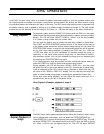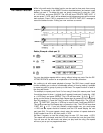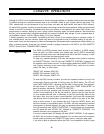
Still in the editing mode, you can now use the -1/NO and +1/YES keys and locate
the repeats, which are displayed just before the corresponding part (in the case
of Begin Repeat signs) or just after (in the case of End Repeat signs) and once
located, you can delete repeats in the same way as parts (see the DELETING RE-
PEATS section).
You can, if you wish, repeat only one part. This is quite common-you may often
want to repeat the same part, say, eight times, for a verse section, for example. In
this case, having entered the Begin Repeat sign, pressing the +1/YES key will
move you to the “other side" of the part in which you inserted a Begin Repeat sign,
and you can enter an End Repeat sign as previously described. If you try to enter
a Begin Repeat sign at a part that already has one, you’ll see the “ALREADY EN-
TERED!” LCD message, followed by the normal editing display. The same goes
for an End Repeat sign.
A number of repeats can be programmed into one song, to create complex song
arrangements. This also minimizes programming time, as you can enter repeat signs
instead of having to program in large numbers of individual patterns.
Entering Repeats (Example: repeat parts 2 and 5, 3 times)
Deleting Repeats
If a part contains a repeat, deleting the part will also delete the repeat. You can
delete the repeat only, without deleting the part, as follows. Simply use the -1/NO
and +1/YES keys to locate the repeat command, which will be displayed just before
the corresponding part (in the case of Begin Repeat signs) or just after (in the
case of End Repeat signs). For example, the repeats we entered into our song will
be displayed as follows:
31


















